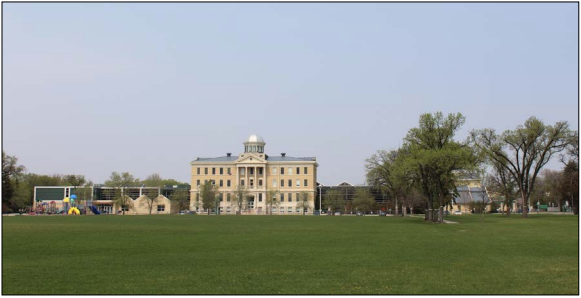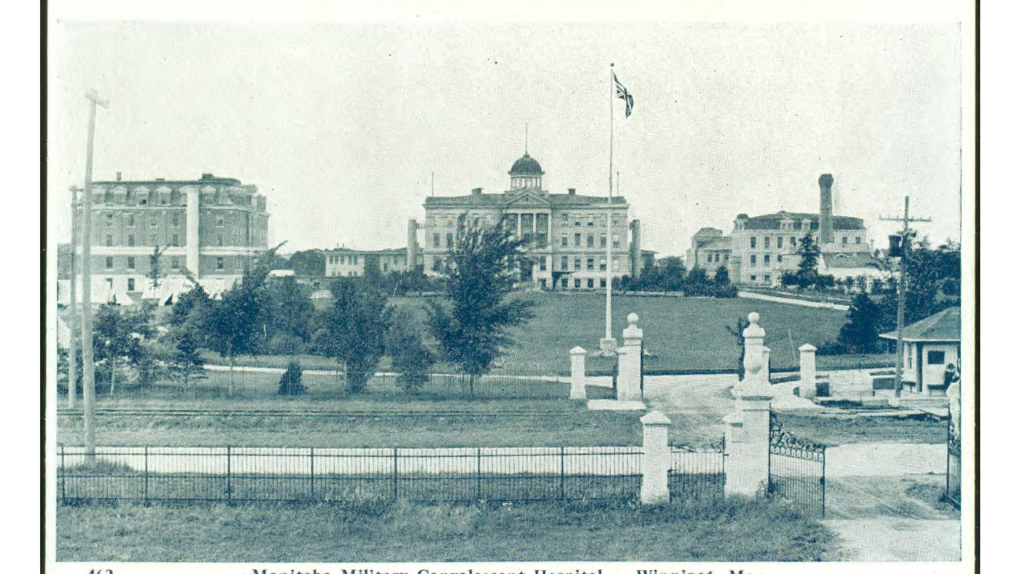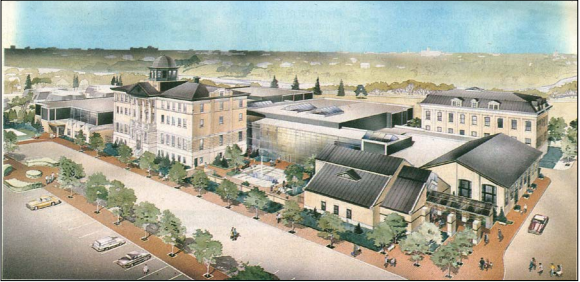
/ Blog
November 11, 2019
Military Maneuvers: Remembering the Fort Osborne Barracks
There have been a variety of Fort Osborne’s in Winnipeg.
The very first opened in 1873, along the banks of the Assiniboine River. A wooden fort, much like Fort Garry and Fort Gibraltar, it sat on the lot that would one day become home to the Manitoba Legislature. The Fort’s wooden structures would be torn down and replaced as Winnipeg grew – though the Fort remained on in the same location well into the First World War. It was here that the Royal Canadian Mounted Battalion, Lord Strathcona’s Horse and Princess Patricia’s Canadian Light Infantry would congregate and train during the early years of the war effort.
As concerns mounted about “enemy aliens” in Canada over the course of the First World War, the government of Canada began utilizing Fort Osborne as a processing station for the thousands of Germans and Ukrainians who were sent to internment camps in the 1910s. Known as the Winnipeg Receiving Station, Fort Osborne’s station would operate from 1914-1916; at this point the Legislature’s construction forced the closure and relocation of Fort Osborne.
 |
| A military parade on the old Fort Osborne Barracks grounds. The wooden building in the background is the old drill hall. Source: Winnipeg Past Forward Collection. |
Their next chosen location, unusually enough, was not purpose-built for military use.
Instead, the selected spot was University of Manitoba’s original Agricultural College Campus at 123 Doncaster Street. By the 1900’s, Manitoba’s economy was based heavily in agriculture, and the province was looking to fund additional agricultural research. As a result, the Manitoba Agricultural College was created between 1903-1904, with classes in “crop and livestock production, farm management and, eventually, home economics” (City of Winnipeg Report, 2018).
Upon its official opening in 1906 the Agricultural College was the first school of its kind in Western Canada and the third in all of Canada. As the campus grew, a range of buildings including a dormitory and other classroom spaces would open to meet the needs of incoming students.
The Administration Building, which still stands today, was by designed by Provincial Architect Samuel Hooper. Built in the Classical Revival Style for $102,000, the Administration Building is made of a light grey brick with classical detailing’s on the façade, including a mix of Ionic and Doric columns. Though an impressive campus for the students, it would not be used as a school for long. Within roughly five years of opening, the college had outgrown their 47 hectares plot of land in Tuxedo and moved to a larger, 250 hectare site near Fort Garry (the University of Manitoba stands there today).
For a brief, three-year period, between 1913-1917 the old Agricultural College housed the Manitoba School for the Deaf. Regardless of the School’s long-term plans, their tenure was short-lived. The Dominion Government acquired the building in 1917, with plans to repurpose the building as a convalescent and rehabilitation center for returning soldiers.
The First World War had a devasting impact both overseas and on the home front. Canadian men enlisted en masse to join the war effort, and those at home were left to fill in the gaps in labour and family life. Across Canada, over 61,000 Canadians would die fighting in World War One. Another 172,000 were injured, not counting those who returned home with undiagnosed mental and physical injuries. In Winnipeg, there were at least 1,169 men who died in combat.
Still, many of those who survived the war would still be changed forever. Recovering at home or in a military hospital, like the one at Fort Osborne, gave soldiers a chance to recover and heal before reacclimating to daily life. Within several years, though, convalescing facilities shifted to operate exclusively out of Deer Lodge Centre and the former Agricultural College was turned into the army’s main base in Winnipeg. Though it was initially known as the Tuxedo Cavalry Barracks, the name would change into the Fort Osborne Barracks by the 1930s.
The ample land space the Agricultural College had enjoyed proved useful to the newly opened barracks. During the interwar period, between the 1920s and 30s, Fort Osborne’s mounted troops utilized the expanse of land to host the Annual Mounted Games, where Lord Strathcona’s Horse could test their riding skills against the Royal Canadian Mounted Battalion.
The Fort Osborne Barracks also became the home to the A and D companies of Princess Patricia’s Canadian Light Infantry. Named for Princess Patricia of Cannaught, the Princess Patricia’s were formed in August of 1914, shortly after the outbreak of the First World War. Over the course of the next four years, the Patricia’s would take part in many significant battles including Vimy Ridge and Passchendaele. Ultimately, by the end of the war, the Patricia’s had lost 1,272 of their enlisted men.
Once the war had ended, with members of the companies now based in Winnipeg, Captain Tommy James reformed and reunited the Patricia’s regimental band in 1919. In 1922, under the leadership of Captain James, the band participated in a local radio broadcast organized by the Winnipeg Tribune.
Unfortunately, peace in North America was not long-lasting, and the outbreak of World War II in 1939 threw the world into chaos yet again. Much like they had twenty years earlier, many young Canadians rushed to be involved, and the Fort Osborne Barracks served as a recruitment and training hub. Interested men and women were invited down to enlist through advertisements in the paper, and fundraising dances were held on a regular basis. Though initially a barracks exclusively for male soldiers, this changed in 1943 when Fort Osborne went co-ed. Spaces were created for women’s auxiliary forces, and new recruitment posters went out encouraging women to turn up and enlist.
By the 1950s, the army had outgrown their facilities and moved to the Kapyong Barracks. After operating as office space for several years, the Agricultural College was vacant by the 1980’s. Plans to redevelop the old Agricultural College came and went but by end of the decade the fate of the building was still undecided. The prospect of demolition was raised and locals pressed to designate the Agricultural College to prevent this possibility. A reporter for the Winnipeg Sun ran a poll in 1988, and announced that 88% of surveyed residents were in favour of historic designation.
Advocates for the building stressed the importance of the Agricultural College’s role in the military history of both Winnipeg, and Canada; acting as a social hub for soldiers in the interwar period, and later as place of recruitment and training, the Fort Osborne Barracks played an instrumental part of the life on the home front.
The fight to save the building continued for years after the poll was published. In 1989, one man, an A. Bedbrook, wrote in to the Winnipeg Free Press to advocate for the building:
Some 53 years ago, I walked through the gates of Fort Osborne Barracks and became a soldier. A few weeks ago, I took a nostalgic walk through that same Fort Osborne Barracks that held so many memories for the young men of the prairies, young men that trained in these same barracks to become the nucleus of the Canadian First Division, “C” Bty. Royal Canadian Horse Artillery, Lord Strathcona’s Horse, and Princess Patricia’s Canadian Light Infantry.
Bedbrook went on to add, “Fort Osborne has as much significance to the history of Western Canada and some of Canada’s famous regiments, as the Forks has to the fur trade and the voyageur.” (Winnipeg Free Press, January 30, 1989).
An important component of heritage preservation is the human connection to these buildings. How we use, adapt, and rely on these spaces play an important role in community building and fostering a sense of local identity. For many years, the Manitoba Agricultural College was important part of military life in Winnipeg, and played a role for so many that fought for our country.
 |
| The Administration Building, as seen in 2016. Source: Murray Peterson, City of Winnipeg Building Report (139 Tuxedo Avenue) |
Thankfully, the Government of Manitoba recognized the significance of the campus and designated the site in 1995. In 1997, the site was developed as the Asper Jewish Community Campus – turning it back into a school once again. In 2018, the City of Winnipeg added the Administration Building to its list of historical resources.
There is little evidence of military use on the campus grounds today, though plaques on the property remind us of a history we strive to remember.
SOURCES:
Manitoba Museum: Winnipeg Receiving Station
Global News: Mapping Winnipeg’s First World War Dead
City of Winnipeg Building Report: 139 Tuxedo Avenue
Canadian Military History, Bruce Forsyth
Fort Osborne Wiki
Princess Patricia’s Canadian Light Infantry
Winnipeg Evening Tribune
The Manitoban
Heritage Winnipeg Files
THANK YOU TO THE SPONSOR OF THIS BLOG POST:

Written by Sabrina Janke on behalf of Heritage Winnipeg.












